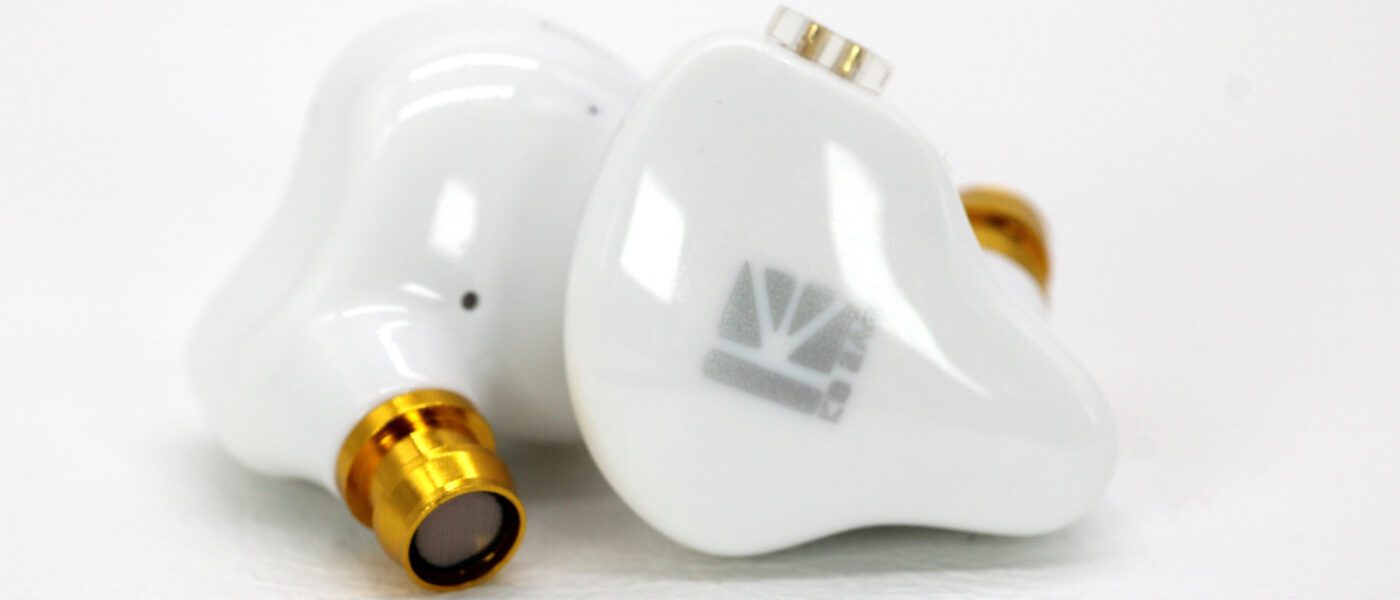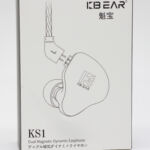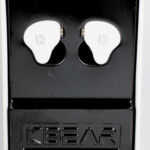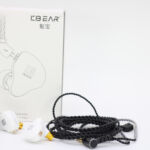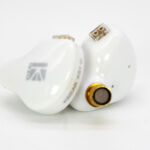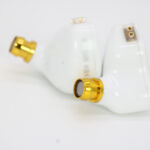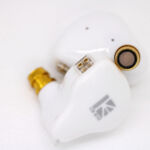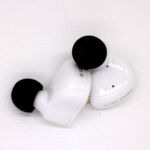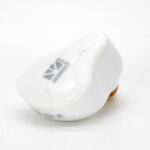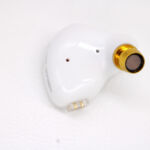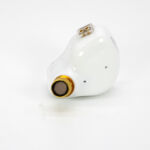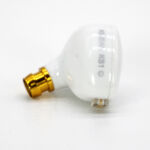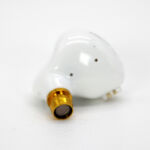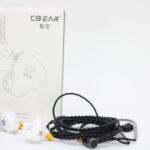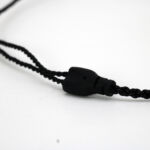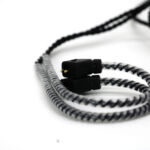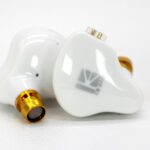KBear KS1
disclaimer: KBear volunteered the KS1 for review and graciously sent them. I have no financial interest in KBear or any of its resellers, nor have they had any input into the content of this review. If you have an interest in KBear, please see their facebook page or Aliexpress store.
Unboxing / Packaging:
Those familiar with the typical small white slip-cover style box will immediately recognize the packaging. Line drawing and name on front, specs on rear of slip cover. Inside, the box, we have the earpieces resting in a black plastic tray with the rest of the kit hiding underneath. The kit consists of earpieces, cable, and three sets (SML) of silicone tips. The kit seems pretty spartan even for a budget model but I’d much rather see money spent in R&D and driver components than on another clamshell case. Remembering that these retail for less than 20 USD, we do have to temper our expectations accordingly.
Build/Fit:
The Ks1 follows a very similar pattern to the earlier KS2 I reviewed (at least on the exterior) with a 4 part shell made of white resin face and inner shell, clear plastic bi-pin housing, and brass nozzles. Unlike the KS2, the KS1 uses an opaque material so the internals are not visible even in bright light. The KBear logo is on the front of the shell with KBear KS1 and L/R marked in matching gray across the rear surface. The shell is of the semi-custom shape with two vents on the under side of the shell, one immediately above the nozzle and a second in line vertically above that. Nozzles have a forward and upward rake that helps with insertion depth and allows better isolation than the KS2 provided. This is probably partially due to a bit thicker shell as well. Fit and polish are good with seams tightly sealed and no glue, gaps, or slop.
Internals:
The heart of the KS1 is a 10mm dual magnet dynamic driver with a PET diaphragm. Nominal impedance is listed as 16Ω with a sensitivity of 109 dB/mW. KBear lists an aluminum wave guide and a rear cavity designed into the driver to help tune the Ks1 along with the shell material itself being selected to reduce resonances and reflected sound from the rear of the driver. I had no trouble using the KS1 from my phone dongles but did find it scales some both qualitatively (better bass detail) and quantitatively with improved sources. Overall I would list the KS1 as does not require an amp, but will benefit from at least a step up from phone /tablet to dongle.
Cable:
This is a very familiar cable by this point. Those familiar with KB budget offerings will recognize the cable immediately although there are some differences from the previous generation. The cable still starts out with a 90º jack in black housing with a silver ring accent and a proper strain relief. The cable is listed as four core 4N copper and is encased in black plastic matching the jack instead of the brown casing used on the KS2. The cable is a double helix cable up to the splitter which is the standard black plastic Y style. Above the splitter cables are twisted pairs and terminate with pre-formed earhooks without memory wire and .78mm bi-pin connectors in black housings with R/L stamped in the sides for ease of indexing. Connectors are of the hooded type and provide a bit of extra stability by encasing the mating connector on the earpiece.
Sound:
Bass:
The Ks1 has an elevated sub-bass with a center around 55Hz before a gradual drop back as it moves up through the mid-bass. The sub-bass is improved over the KS2 stable-mate with a bit faster attack and decay and improved detail as a result. The KS1 can rumble, when called upon, but is less noticeable when not highlighted and cleaner transients. The KS2 was a little monotone in the lows and the KS1 definitely has more life here. Mid-bass has good slam and enough texture to be believable (again remember this is a $20 spend). There is some minor mid-bass bleed but here again markedly improved over the Ks2 and a much more pleasant listen. The KS1 still packs enough low end power to make EDM and hip-hop fun, but is better balanced and works well for rock as well where bass has to be faster and more textured to work well.
Mids:
Lower mids have a little extra warmth and weight thanks to the bass bleed, but other than making lower vocals sound a little thicker, it does little to obstruct the lower mids. The lower mids do continue to fall back as we move up with the trough of the V somewhere between 600Hz and 1kHz. Guitar growl is good with nice texture and good tonality but strings lack a bit of energy needed in that same region to be fully realized. Almost as quickly as the mids bottom out, they start a climb forward again that push female vocals forward in the mix and put them a step in front of both the other instruments and their male counterparts.
Treble:
Lower treble drops back again after the upper-mid rise but comes back up to the upper-mid peak at around 5kHz which adds enough energy to help with snare rattle and hi-hat hits. Unfortunately, the next peak at 9kHz that was probably meant to contribute some addition air and sparkle can also make the KS1 sound a bit splashy and harsh at times. It doesn’t come through full time, but is enough that if a track has an emphasis in that range it gets strident quickly. Extension is only average with a fairly steep roll-off above that 9kHz peak that limits air at the top end. Overall, good treble detail but its tuning will be polarizing.
Soundstage/Imaging:
Stage has good width and some depth but is definitely wider than deep and height is somewhat limited as well. I was surprised here as the KS2 was above average in stage and here the KS1 drops back a step and while still good is not quite the equal of its sibling. Seating the orchestra is better than the KS2 as instrument separation is improved compared to the KS2 and the driver speed definitely is noticeable here. Layering is average with some compression as tracks get more complex. Imaging is about average (again a step better than KS2) with movements easily tracked and fairly well defined in space.
Thoughts/Conclusion:
I wasn’t a huge fan of the KS2 and honestly wasn’t expecting the KS1 to fare a lot better considering it was “a KS2 with the BA deleted”. Happily I was wrong, the drivers used in the KS1 and 2 are not the same and the KS1 is faster, cleaner, and generally better behaved than its sibling. I’m not a huge fan of the treble tuning as that 9kHz spike hits precisely at a point where I am sensitive and to my ear, that needs some EQ to be usable. Others who don’t have that particular sensitivity and those willing to EQ that range down a bit are greeted with a very pleasant signature with good detail and speed. While I still like the KB04 in the sub-$25 space, I have to admit the KS1 does offer those looking for a single dynamic driver model a solid option in that same space. KBear keeps getting better and the prices have stayed down so far. Lets hope that trend continues.
-
Bass - 7/107/10
-
Mids - 6/106/10
-
Treble - 6/106/10
-
Soundstage - 6/106/10
-
Imaging - 6.5/106.5/10
Summary

